Cnidarian - Study guides, Class notes & Summaries
Looking for the best study guides, study notes and summaries about Cnidarian? On this page you'll find 41 study documents about Cnidarian.
Page 3 out of 41 results
Sort by
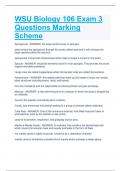
-
WSU Biology 106 Exam 3 Questions Marking Scheme
- Exam (elaborations) • 18 pages • 2024
- Available in package deal
-
- $11.99
- + learn more
WSU Biology 106 Exam 3 Questions Marking Scheme Spongocoel - ANSWER- the large central cavity of sponges. water enters the spongocoel through tiny pores called ostia and it exits through the large opening called the osculum. spongocoel is lined with choanocytes which help to create a current in the water. Spicule - ANSWER- structural elements found in most sponges. They provide structural support and deter predators. Large ones are called megascleres while microscopic ones are called mi...
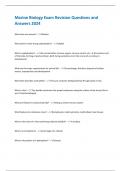
-
Marine Biology Exam Revision Questions and Answers 2024
- Exam (elaborations) • 2 pages • 2024
-
- $4.49
- + learn more
What class are mussels? - Bivalvia What doesn't show strong cephalization? - Jellyfish What is cephalization? - the concentration of sense organs, nervous control, etc., at the anterior end of the body, forming a head and brain, both during evolution and in the course of an embryo's development. What are the major requirements for animal life? - Gas exchange, Nutrition, disposal of cellular wastes, reproduction and development What best describes comb jellies? - They are creatures di...
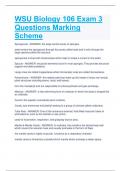
-
WSU Biology 106 Exam 3 Questions Marking Scheme
- Exam (elaborations) • 18 pages • 2024
-
- $8.99
- + learn more
WSU Biology 106 Exam 3 Questions Marking Scheme Spongocoel - ANSWER- the large central cavity of sponges. water enters the spongocoel through tiny pores called ostia and it exits through the large opening called the osculum. spongocoel is lined with choanocytes which help to create a current in the water. Spicule - ANSWER- structural elements found in most sponges. They provide structural support and deter predators. Large ones are called megascleres while microscopic ones are called mi...
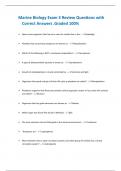
-
Marine Biology Exam 3 Review Questions with Correct Answers .Graded 100%
- Exam (elaborations) • 3 pages • 2024
-
- $5.49
- + learn more
Open ocean organisms that live at or near the surface live in the: - Epipelagic Plankton that are primary producers are known as: - Phytoplankton Which of the following is NOT a crustacean zooplankton? - Ctenophores A type of photosynthetic bacteria is known as: - Cyanobacteria Growth of phytoplankton is mostly controlled by: - Nutrients and light Organisms the spend only part of their life cycle as plankton are called? - Meroplankton Planktonic organism that float just beneath surf...
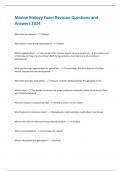
-
Marine Biology Exam Revision Questions and Answers 2024
- Exam (elaborations) • 2 pages • 2024
-
- $3.49
- + learn more
What class are mussels? - Bivalvia What doesn't show strong cephalization? - Jellyfish What is cephalization? - the concentration of sense organs, nervous control, etc., at the anterior end of the body, forming a head and brain, both during evolution and in the course of an embryo's development. What are the major requirements for animal life? - Gas exchange, Nutrition, disposal of cellular wastes, reproduction and development What best describes comb jellies? - They are creatures di...
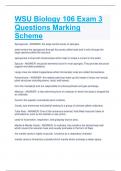
-
WSU Biology 106 Exam 3 Questions Marking Scheme
- Exam (elaborations) • 18 pages • 2023
-
Available in package deal
-
- $13.09
- + learn more
WSU Biology 106 Exam 3 Questions Marking Scheme Spongocoel - ANSWER- the large central cavity of sponges. water enters the spongocoel through tiny pores called ostia and it exits through the large opening called the osculum. spongocoel is lined with choanocytes which help to create a current in the water. Spicule - ANSWER- structural elements found in most sponges. They provide structural support and deter predators. Large ones are called megascleres while microscopic ones are called ...
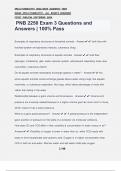
-
PNB 2250 Exam 3 Questions and Answers | 100% Pass
- Exam (elaborations) • 40 pages • 2024
- Available in package deal
-
- $12.49
- + learn more
PNB 2250 Exam 3 Questions and Answers | 100% Pass Examples of respiratory structures of terrestrial animals - Answer-bulk flow with tracheal system and spiracles (insects), cutaneous (frog) Examples of respiratory structures of aquatic animals - Answer-bulk flow (sponges, cnidarians), gills, water vascular system, arborescent respiratory trees (sea cucumber), cutaneous (leech) Do all aquatic animals necessarily exchange gasses in water? - Answer-No, some aquatic animals could exchange ga...
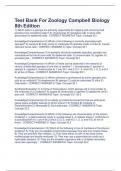
-
Test Bank For Zoology Campbell Biology 8th Edition
- Exam (elaborations) • 12 pages • 2023
-
- $16.49
- + learn more
Test Bank For Zoology Campbell Biology 8th Edition 1) Which cells in a sponge are primarily responsible for trapping and removing food particles from circulating water? A) choanocytes B) mesoglea cells C) pore cells (porocytes) D) epidermal cells - CORRECT ANSWER-A Topic: Concept 33.1 Knowledge/Comprehension 2) Which of the following is correctly associated with sponges? A) osculum B) body cavity C) cnidocytes D) spicules made of chitin E) muscle cells and nerve cells - CORRECT ANSWE...
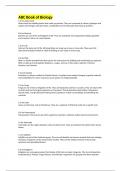
-
ABC Book of Biology
- Exam (elaborations) • 3 pages • 2024
-
Available in package deal
-
- $9.79
- + learn more
ABC Book of Biology A is for Amino Acid Amino Acids are building blocks that make up proteins. They are composed of carbon, hydrogen and oxygen and nitrogen and side chains. Combinations of 20 molecules that make up proteins. B is for Bacteria Bacteria are one of the six kingdoms of life. They are unicellular microorganisms lacking organelles and a nucleus. Some can cause disease. C is for Cell Cells are the basic unit of life. All living things are made up of one or more cells. Th...
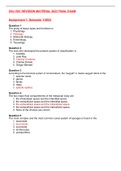
-
ZOL1501 REVISION MATERIAL 2023 FINAL EXAM
- Exam (elaborations) • 19 pages • 2023
-
- $15.99
- + learn more
ZOL1501 REVISION MATERIAL 2023 FINAL EXAM Assignment 1: Semester 1/2023 Question 1 The study of tissue types and functions is 1. Physiology. 2. Histology. 3. Molecular Biology. 4. Entomology. 5. Tissuology. Question 2 The man who developed the present system of classification is 1. Aristotle. 2. John Ray. 3. Carolus Linnaeus. 4. Charles Darwin. 5. Gregor Mendel. Question 3 According to the binomial system of nomenclature, the "aegypti" in Aedes aegypti refers t...

How did he do that? By selling his study resources on Stuvia. Try it yourself! Discover all about earning on Stuvia


